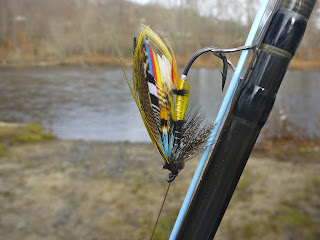 |
| Ol' faithful...Sage Graphite II - 9' 7 wt. |
Part II of the Connecticut broodstock Atlantic salmon series deals with what you'll need in the tackle and gear department. It is possible to travel really lightly. That said, I love to tie flies, so I tend to have more with me than I'd use in the next sixty seasons. I am constantly thinking about scaling back, but it never actually happens. Maybe this year...
Most of the CT salmon I have caught in the past have averaged about 8-10 lbs., give or take. In an average season, I probably catch about as many small salmon (3-6 lbs.) as I do large salmon (15 lbs. +). Some years, salmon in the 25-30+ lb. range were stocked. Even a lethargic 25 lb. salmon would be a chore to land on a 5 wt. rod. A spirited fish that size might break your rod or even die from being overplayed, so please don’t try to be the next Lee Wulff. Try to fight them fast and hard with tackle matched to the size of your quarry.
9’ 7 wt. Sage Graphite II*
11’ 6 wt. Sage Z-Axis switch rod*
11’3” 7 wt. Redington CPX switch rod*
13’ 7/8 wt. Korean-made spey rod
Rods:
10’-11’ switch rods for 5-7 wt. lines
12'+ spey rods for 5-7 wt. lines
 |
| This 13' spey rod came in handy in very high and cold water |
Reels, Line and Backing:
 |
| A 2/0 Jock Scott w/sinking polyleader and Maxima Chameleon |
Other Gear:
Warm clothes/layers - It probably goes without saying, but this is a necessity for fishing cold weather. Don’t forget your hat and gloves.





This comment has been removed by a blog administrator.
ReplyDelete